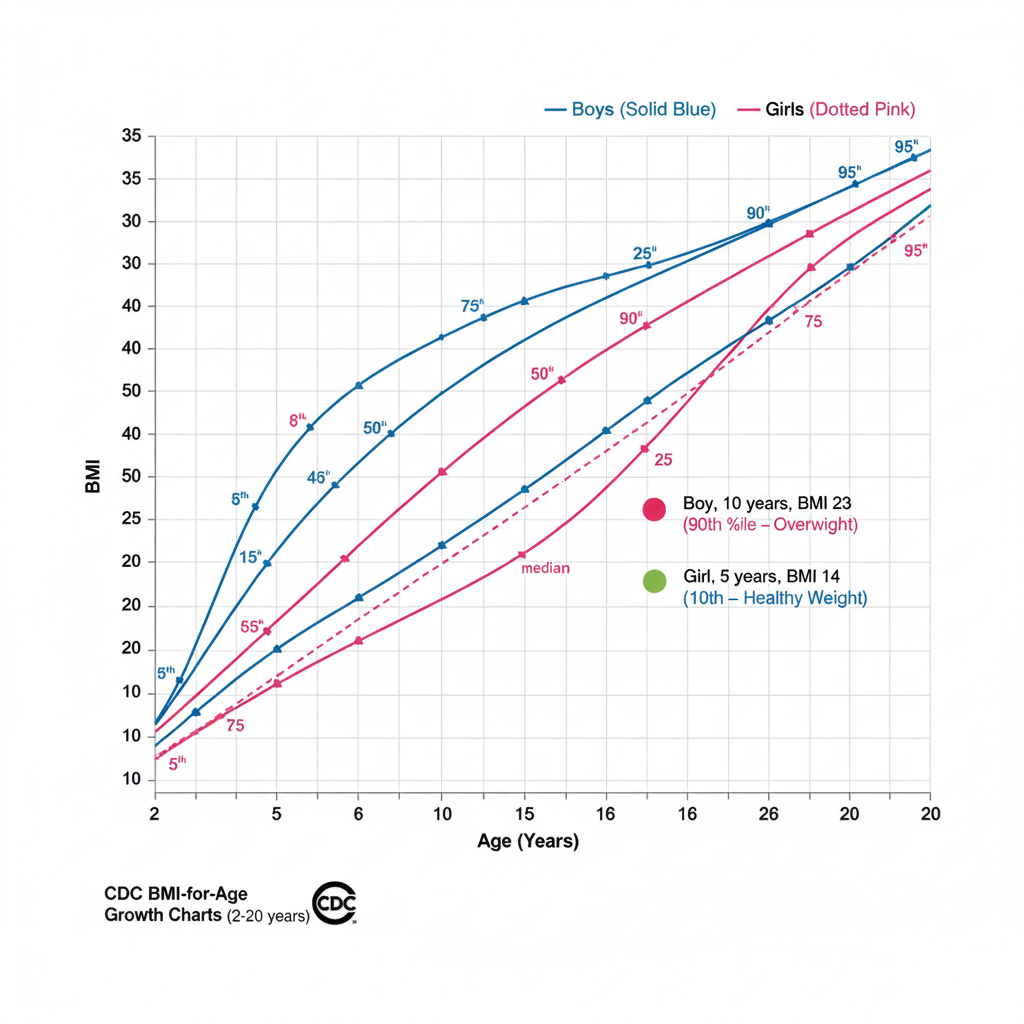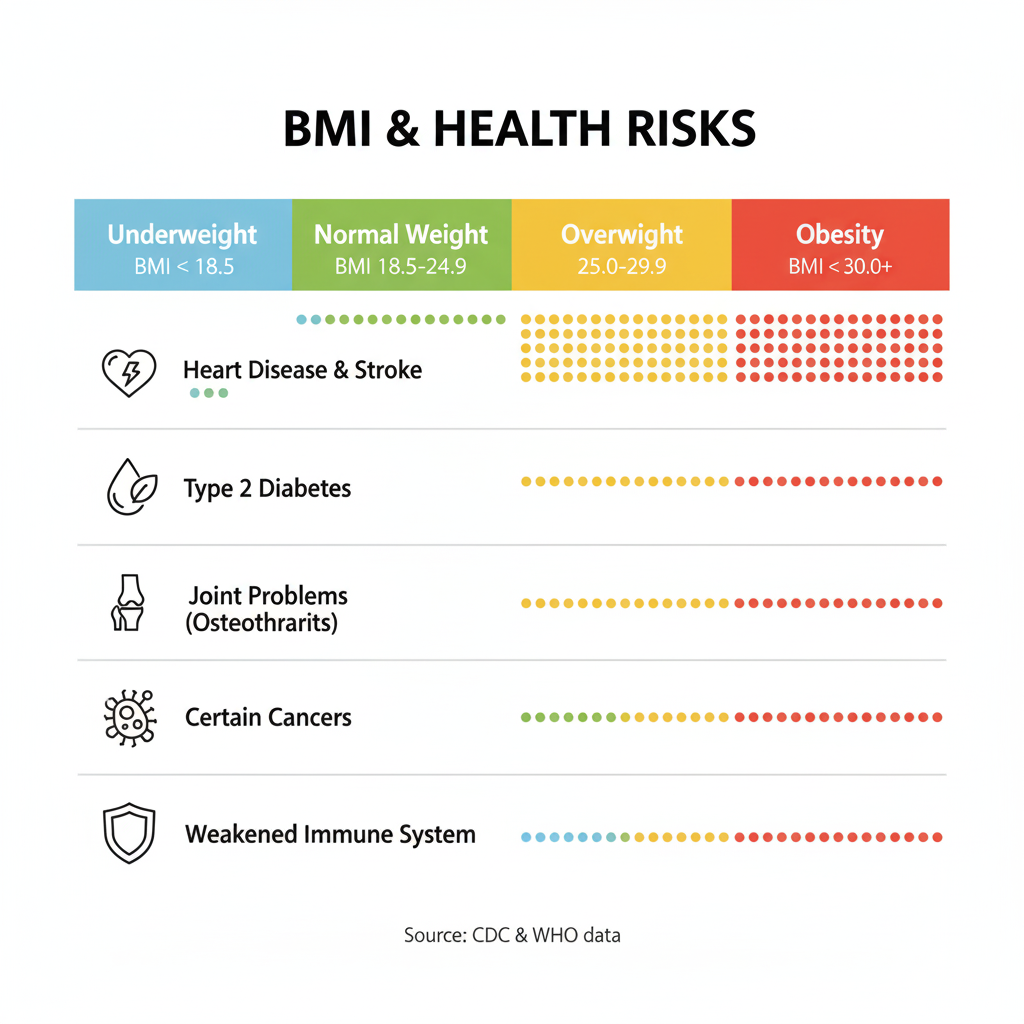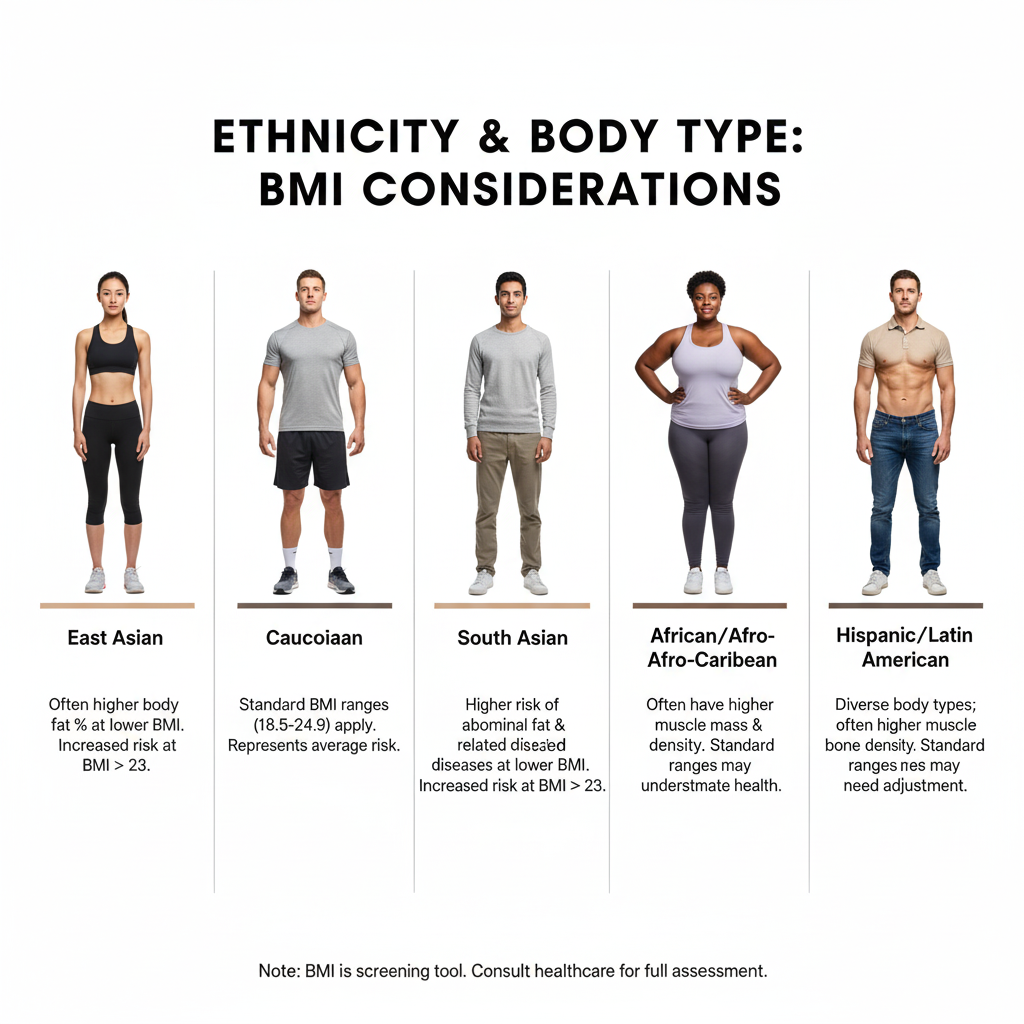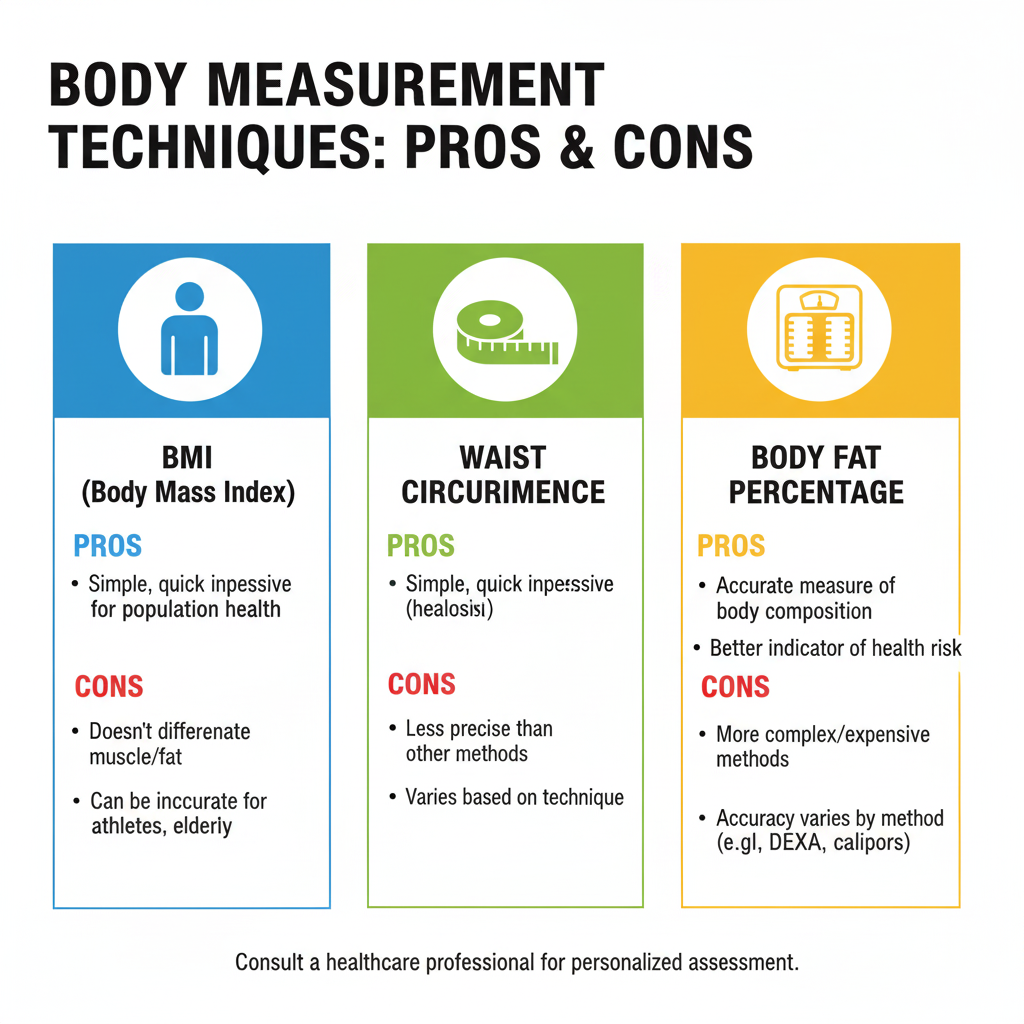Welcome to our comprehensive guide on Body Mass Index (BMI), one of the most widely used tools for assessing weight-related health risks. Whether you're beginning a health journey, monitoring your progress, or simply curious about what BMI means, this guide will provide you with everything you need to know.
At Proculator, we believe that understanding your health metrics is the first step toward making positive changes. That's why we've created this in-depth resource to help you navigate the world of BMI, its significance, limitations, and how to use it effectively alongside other health indicators.

What Exactly is Body Mass Index (BMI)?
Body Mass Index, commonly known as BMI, is a simple numerical measure that relates your weight to your height. It's calculated by dividing your weight in kilograms by your height in meters squared (kg/m²). Originally developed in the 19th century by Belgian mathematician Adolphe Quetelet, BMI was designed to identify "average man" characteristics for statistical purposes.
It wasn't until the 1970s that researcher Ancel Keys popularized the term "Body Mass Index" and demonstrated its value as a population-level indicator of body fatness and associated health risks. Since then, BMI has become a standard tool used by healthcare professionals worldwide to quickly assess weight status and potential health risks.
Key Point: BMI is not a direct measurement of body fat, but rather a screening tool that correlates with body fat for most people. It provides a simple, standardized way to categorize weight status across populations.
The Historical Context of BMI
The concept of relating weight to height dates back to the 19th century. Adolphe Quetelet, a Belgian astronomer, mathematician, and statistician, developed the Quetelet Index during his research on social physics. His goal was to find the "average man" (l'homme moyen) by studying human physical characteristics and social traits.
Quetelet noticed that for most people, body weight increased in proportion to the square of height. This observation formed the basis of what we now know as BMI. Interestingly, Quetelet never intended his index to be used as a health assessment tool—it was purely a statistical concept.

In 1972, physiologist Ancel Keys published the seminal paper "Indices of Relative Weight and Obesity," where he evaluated several height-weight indices and concluded that the Quetelet Index was the most useful for population studies. Keys renamed it the Body Mass Index, and the term stuck. Since then, BMI has been adopted by organizations like the World Health Organization (WHO) and the National Institutes of Health (NIH) as a standard measure for tracking obesity trends.
How to Calculate Your BMI
Calculating your BMI is straightforward, and you can do it using either metric or imperial measurements. Here are the formulas:
Metric Formula (most common)
BMI = weight (kg) / height² (m²)
Imperial Formula
BMI = [weight (lbs) / height² (in²)] × 703
Let's walk through an example calculation for both systems:
Metric Example:
If you weigh 68 kg and are 1.75 m tall:
BMI = 68 ÷ (1.75 × 1.75) = 68 ÷ 3.0625 = 22.2
Imperial Example:
If you weigh 150 lbs and are 5'7" (67 inches) tall:
BMI = [150 ÷ (67 × 67)] × 703 = [150 ÷ 4489] × 703 ≈ 0.0334 × 703 ≈ 23.5
Why 703? The conversion factor 703 comes from converting inches to meters and pounds to kilograms. Specifically, it's calculated as (1 kg / 2.2 lbs) × (39.37 inches / 1 m)² ≈ 703.
While manual calculations are educational, our BMI Calculator can do the math for you instantly and accurately, eliminating potential calculation errors.
BMI Calculation for Children and Teens
For children and adolescents aged 2-19, BMI is calculated differently. Instead of fixed categories, pediatric BMI is expressed as a percentile relative to other children of the same age and sex. These percentiles are based on growth charts developed by the Centers for Disease Control and Prevention (CDC).
The formula for calculating BMI is the same, but the interpretation differs:
- Underweight: BMI below the 5th percentile
- Healthy weight: BMI between the 5th and 85th percentiles
- Overweight: BMI between the 85th and 95th percentiles
- Obese: BMI at or above the 95th percentile

BMI Categories and What They Mean
The World Health Organization (WHO) has established standard BMI categories to help interpret your results. These categories provide a general indication of whether your weight might be affecting your health.
| BMI Category | BMI Range (kg/m²) | Health Risk |
|---|---|---|
| Underweight | Below 18.5 | Potential nutritional deficiencies, osteoporosis |
| Normal weight | 18.5 - 24.9 | Lowest health risk |
| Overweight | 25 - 29.9 | Moderate health risk |
| Obesity Class I | 30 - 34.9 | High health risk |
| Obesity Class II | 35 - 39.9 | Very high health risk |
| Obesity Class III | 40 and above | Extremely high health risk |
It's important to understand that these categories represent statistical risk levels across populations. Your individual health status may vary based on numerous factors beyond BMI.
Detailed Look at Each BMI Category
Underweight (BMI < 18.5)
Being underweight can indicate insufficient nutrient intake, underlying health conditions, or a naturally slender build. Health risks associated with being underweight include:
- Nutritional deficiencies (especially iron, calcium, and vitamins)
- Weakened immune system
- Osteoporosis and increased fracture risk
- Fertility issues
- Anemia
- Increased surgical complications
Normal Weight (BMI 18.5-24.9)
This range is generally associated with the lowest health risks for most people. However, it's important to note that:
- Body composition matters—someone with a "normal" BMI could still have unhealthy fat distribution
- Lifestyle factors (diet, exercise, smoking) significantly influence health outcomes
- Genetic factors play a role in individual health risks
Overweight (BMI 25-29.9)
People in this category have an increased risk of developing weight-related health problems. The degree of risk depends on factors like:
- Waist circumference
- Fitness level
- Family history of disease
- Other health markers (blood pressure, cholesterol, etc.)
Some research suggests that being slightly overweight might be protective for certain populations, particularly older adults—a phenomenon known as the "obesity paradox."
Obesity (BMI 30+)
Obesity is associated with significantly increased risks of numerous health conditions. The WHO further classifies obesity into three classes:
Class I Obesity (BMI 30-34.9)
Considered moderate obesity. Health risks are substantially increased compared to normal weight. Weight loss of 5-10% can significantly improve health markers.
Class II Obesity (BMI 35-39.9)
Considered severe obesity. Associated with significantly reduced life expectancy and quality of life. More intensive interventions are often needed.
Class III Obesity (BMI 40+)
Considered morbid or extreme obesity. Associated with the highest health risks and most severe limitations. Often requires comprehensive medical intervention.
Understanding the Limitations of BMI
While BMI is a useful screening tool, it has several important limitations that everyone should understand:
1. Doesn't Distinguish Between Muscle and Fat
BMI calculations don't differentiate between muscle mass and fat mass. This means that extremely muscular individuals, such as athletes or bodybuilders, may have a high BMI that incorrectly categorizes them as overweight or obese, despite having low body fat percentages.

2. Doesn't Account for Fat Distribution
Research shows that where your body stores fat matters more than total fat amount. Visceral fat (around abdominal organs) poses greater health risks than subcutaneous fat (under the skin). BMI doesn't reflect this important distinction.
Two people with the same BMI can have very different health risks based on their fat distribution:
- Apple-shaped body (android obesity): Fat stored primarily around the abdomen. Higher risk for heart disease, type 2 diabetes.
- Pear-shaped body (gynoid obesity): Fat stored primarily around the hips and thighs. Lower health risks.
3. Varies by Demographic Factors
BMI interpretations may need adjustment for different ethnic groups, ages, and sexes. For example:
- Asian populations may experience health risks at lower BMI values
- Older adults may have healthier BMI ranges slightly higher than younger adults
- Women typically have more body fat than men at the same BMI
- Different ethnic groups have varying body compositions and fat distribution patterns
4. Doesn't Consider Bone Density
People with larger bone structures or higher bone density may weigh more without having excess body fat, potentially leading to higher BMI calculations that don't accurately reflect their health status.
5. Limited Application for Certain Heights
BMI may be less accurate for very tall or very short individuals because the formula doesn't scale perfectly across all heights.
Important: BMI should never be used as a sole diagnostic tool. It's a screening measure that should be considered alongside other health indicators like waist circumference, blood pressure, cholesterol levels, and family history.
Ethnic Variations in BMI Interpretation
Research has shown that different ethnic groups have varying health risks at the same BMI levels. This has led some organizations to suggest ethnicity-specific BMI thresholds:
| Ethnic Group | Overweight Threshold | Obesity Threshold | Notes |
|---|---|---|---|
| European/Caucasian | 25 | 30 | Standard WHO categories |
| Asian | 23 | 27.5 | Higher health risks at lower BMI |
| Polynesian | 26 | 32 | Naturally larger body frames |
| African | 25 | 30 | But may have less visceral fat at same BMI |
BMI and Health Risks: What the Research Shows
Extensive research has established correlations between BMI categories and various health conditions. Understanding these connections can motivate positive lifestyle changes.
Health Risks Associated with High BMI
Elevated BMI values are associated with increased risk for:
- Cardiovascular diseases: Hypertension, coronary artery disease, heart failure, stroke
- Metabolic disorders: Type 2 diabetes, metabolic syndrome
- Certain cancers: Breast, colon, endometrial, kidney, and esophageal cancers
- Musculoskeletal issues: Osteoarthritis, especially in weight-bearing joints
- Respiratory problems: Sleep apnea, asthma
- Gastrointestinal conditions: Gallbladder disease, GERD
- Mental health concerns: Depression, anxiety, poor self-esteem
- Reproductive issues: Infertility, pregnancy complications

Health Risks Associated with Low BMI
Being underweight also carries health risks, including:
- Nutritional deficiencies
- Osteoporosis and increased fracture risk
- Weakened immune function
- Fertility issues
- Anemia
- Increased surgical complications
- Higher mortality from certain conditions
The relationship between BMI and mortality follows a U-shaped curve, with the lowest risk in the normal weight category and increased risks at both extremes.
The Obesity Paradox
Interestingly, some research has identified what's known as the "obesity paradox"—the observation that in certain populations (particularly those with chronic diseases like heart failure, kidney disease, or COPD), people with overweight or mild obesity sometimes have better survival rates than those with normal weight.
Several theories attempt to explain this paradox:
- Metabolic reserve: Extra weight might provide energy reserves during illness
- Earlier diagnosis: Heavier patients might seek medical attention sooner
- Treatment differences: Obese patients might receive more aggressive treatment
- Selection bias: Studies might not adequately control for confounding factors
Important: The obesity paradox doesn't mean obesity is healthy. It highlights the complexity of body weight and health relationships and the need for individualized assessment.
BMI Considerations for Special Populations
BMI interpretation requires special consideration for certain groups:
Children and Adolescents
For those under 20, BMI is interpreted differently using age and sex-specific percentiles rather than the standard categories. This accounts for normal variations in body composition at different stages of development.
Key points about pediatric BMI:
- BMI changes substantially with age during childhood
- Girls and boys have different growth patterns
- High childhood BMI is associated with increased health risks in adulthood
- Pediatric BMI tracking can identify concerning trends early
Older Adults
For seniors, a slightly higher BMI (24-29) may be protective against osteoporosis and mortality. Muscle mass preservation becomes particularly important with aging.
Considerations for older adults:
- Muscle loss (sarcopenia) can mask obesity when using BMI alone
- Weight loss in older adults can sometimes be concerning
- Functional ability may be more important than BMI number
Athletes and Bodybuilders
As mentioned, high muscle mass can skew BMI results. Additional measurements like body fat percentage provide more accurate assessments.
For athletes, consider:
- Sport-specific ideal body compositions
- Performance metrics alongside body measurements
- Seasonal weight fluctuations in some sports
Pregnant Women
BMI is used to determine appropriate weight gain during pregnancy but should be interpreted by healthcare providers in the context of prenatal care.
General pregnancy weight gain guidelines based on pre-pregnancy BMI:
- Underweight (BMI < 18.5): 28-40 lbs
- Normal weight (BMI 18.5-24.9): 25-35 lbs
- Overweight (BMI 25-29.9): 15-25 lbs
- Obese (BMI 30+): 11-20 lbs
Different Ethnicities
Some ethnic groups have different body compositions and health risk thresholds. For example, many Asian populations have higher health risks at lower BMI values, prompting lower overweight thresholds (23 instead of 25) in some guidelines.

People with Disabilities or Chronic Conditions
Certain medical conditions, medications, and disabilities can affect body weight, composition, and the relationship between BMI and health risks:
- Conditions that cause fluid retention
- Medications that affect weight or metabolism
- Mobility limitations affecting physical activity
- Conditions that affect muscle mass
Strategies for Achieving a Healthy BMI
If your BMI falls outside the healthy range, here are evidence-based strategies for improvement:
For Those with High BMI
- Balanced nutrition: Focus on whole foods, appropriate portion sizes, and nutrient density
- Regular physical activity: Aim for at least 150 minutes of moderate exercise weekly
- Strength training: Build muscle mass to boost metabolism
- Behavioral changes: Address emotional eating, improve sleep, and manage stress
- Professional support: Consider registered dietitians, certified trainers, or weight management programs

For Those with Low BMI
- Calorie-dense nutrition: Incorporate healthy high-calorie foods like nuts, avocados, and olive oil
- Strength training: Build muscle mass through resistance exercises
- Small, frequent meals: Eat every 2-3 hours to increase total calorie intake
- Address underlying issues: Rule out medical conditions that might affect weight
Setting Realistic Goals
When working toward a healthier BMI, it's important to set realistic, sustainable goals:
- Aim for gradual weight change (0.5-1 kg or 1-2 lbs per week)
- Focus on behavior changes rather than just the number on the scale
- Celebrate non-scale victories like improved energy, better sleep, or clothing fit
- Remember that plateaus are normal and part of the process
Remember: Sustainable changes yield the best long-term results. Rapid weight loss or gain often leads to rebound effects. Aim for gradual progress of 0.5-1 kg (1-2 lbs) per week.
The Role of Metabolism
Understanding your metabolism can help you make more effective changes to achieve a healthy BMI. Your Basal Metabolic Rate (BMR) is the number of calories your body needs at rest to maintain basic functions.
Factors that influence BMR:
- Age (BMR decreases with age)
- Gender (men typically have higher BMR)
- Body composition (muscle burns more calories than fat)
- Genetics
- Hormonal factors
You can use our BMR Calculator to estimate your metabolic rate and better understand your calorie needs.
Beyond BMI: Complementary Health Metrics
While BMI provides valuable information, it's most effective when combined with other health assessments:
Waist Circumference
Waist measurement helps assess abdominal fat, which is particularly linked to health risks. Generally, health risks increase if waist circumference exceeds:
- 40 inches (102 cm) for men
- 35 inches (88 cm) for women
To measure your waist circumference correctly:
- Stand and place a tape measure around your middle, just above your hipbones
- Make sure the tape is horizontal around your waist
- Keep the tape snug but not compressing your skin
- Measure after exhaling normally
Waist-to-Hip Ratio
This compares waist circumference to hip circumference, providing additional insight into fat distribution patterns.
Calculation: Waist-to-Hip Ratio = Waist Circumference ÷ Hip Circumference
Health risk increases if the ratio is:
- Above 0.90 for men
- Above 0.85 for women
Body Composition Analysis
Methods like body fat percentage measurements, DEXA scans, or bioelectrical impedance provide more detailed information about fat versus muscle mass.
Healthy body fat ranges:
| Category | Women | Men |
|---|---|---|
| Essential Fat | 10-13% | 2-5% |
| Athletes | 14-20% | 6-13% |
| Fitness | 21-24% | 14-17% |
| Average | 25-31% | 18-24% |
| Obese | 32%+ | 25%+ |
Other Health Indicators
Blood pressure, cholesterol levels, blood sugar, and fitness level all contribute to a comprehensive health assessment.

Frequently Asked Questions About BMI
Is BMI an accurate measure of health?
BMI is a useful screening tool for population-level assessment but has limitations for individuals. It doesn't distinguish between muscle and fat, account for fat distribution, or consider individual variations. It should be used alongside other health indicators for a complete picture.
Why do athletes often have high BMI?
Muscle is denser and heavier than fat. Athletes and bodybuilders with significant muscle mass may have high BMI values that incorrectly categorize them as overweight, despite having low body fat percentages.
How often should I check my BMI?
For most adults, checking BMI every 1-3 months is sufficient to track trends. Daily or weekly measurements aren't necessary as normal weight fluctuations can create misleading patterns.
Can BMI be different for men and women?
While the BMI calculation is the same, interpretation may vary slightly. Women naturally have higher body fat percentages than men at the same BMI. Additionally, healthy BMI ranges may differ slightly based on physiological differences.
At what age is BMI not accurate?
BMI requires age-specific interpretation for children and teens. For older adults, a slightly higher BMI may be healthier than for younger adults. There's no specific age when BMI becomes "inaccurate," but its interpretation should consider life stage.
What is a better alternative to BMI?
While no single measure is perfect, combinations of metrics provide better assessments. These include waist circumference, waist-to-hip ratio, body fat percentage, and health markers like blood pressure and cholesterol levels.
Can BMI be inaccurate for tall or short people?
Yes, BMI may be less accurate for very tall or very short individuals because the formula doesn't scale perfectly across all heights. Some researchers have proposed alternative formulas like the Ponderal Index for these populations.
How does BMI relate to mental health?
There are complex relationships between BMI and mental health. Higher BMI is associated with increased risk of depression and anxiety, potentially due to social stigma, discrimination, or biological factors. However, some mental health conditions and medications can also affect weight.
Ready to Calculate Your BMI?
Use our accurate and easy-to-use BMI calculator to assess your weight status and start your health journey today.
Calculate Your BMI NowConclusion: BMI as Part of a Holistic Health Approach
Body Mass Index remains a valuable, though imperfect, tool for assessing weight-related health risks. Its simplicity and standardization make it useful for population screening and tracking trends over time. However, BMI should never be viewed in isolation or as a definitive measure of health.
The most effective approach to health assessment combines BMI with other metrics like waist circumference, body composition analysis, blood markers, and overall lifestyle evaluation. Remember that numbers are guides, not judgments—what matters most is how you feel, your energy levels, and your ability to engage fully in life.
Whether your BMI indicates a need for change or confirms you're in a healthy range, focus on sustainable habits rather than quick fixes. Nutrition, physical activity, stress management, and quality sleep form the foundation of lasting health, regardless of what the scale says.
At Proculator, we're committed to providing you with the tools and information you need to make informed decisions about your health. Explore our suite of health calculators to gain deeper insights into your wellbeing.
Final Thought: Your health journey is unique to you. While tools like BMI can provide valuable guidance, the most important measure of health is how you feel in your body and your ability to live life to its fullest.